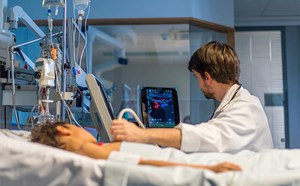
ACEP EUS Safety Subcommittee Update
Daniel Mirsch DO
@DanMirsch
Chair Elect, US Section Safety Sub-Committee, University at Buffalo
Christopher Kumetz MD
@CKumetzMD
Chair, US Section Safety Sub-Committee, NCH Emergency Departments
Jason T Nomura MD FACEP
@Takeokun
Past Chair, US Section Safety Sub-Committee, Christiana Care of Delaware
The safety subcommittee has been hard at work over recent years with some remarkable accomplishments. We continue to benefit from excellent leadership with Dr. Kumetz as chair, Dr. Nomura as immediate past chair, and newly brought on chair elect, Dr. Daniel Mirsch, to support our endeavors. Let us review our recent developments and current projects.
Joint Industry Roundtable
This webinar from the Safety and Emerging Technology Subcommittees found multiple areas of improvement. We are in discussions with manufacturers to have more common language used in the Manufacturer Instructions For Use (MIFU) to decrease conflicts with evidence and JCAHO. To further this goal, we seek to form a collaborative between clinicians, manufacturers, and the FDA to create better, more consistent MIFU language.
We are also discussing with industry leaders concerns from ACEP EUS members such as methods to decrease the crevices on probes that make cleaning difficult or incomplete using standard wipes. Industry leaders were asked to assist with improved design to eliminate these cleaning difficulties.
Disinfection
For details, definitions, and basics on ultrasound disinfection please review the ACEP’s Policy Statement on “Guideline for Ultrasound Transducer Cleaning and Disinfection.”1 Here we will review the accomplishments of the Safety Subcommittee this past year.
The impact of the Disinfection of Ultrasound Transducers used for Percutaneous Procedures: Intersocietal Position Statement2 continues to be felt. The AIUM updated their guidelines in December 2022, and removed its recommendation for high level disinfection on probes contaminated with blood.3 This will greatly assist those developing emergency department protocols that do not have access to departmental sterilization equipment.
Section members should also be aware that the most recent AIUM guidelines include provisions for low resource settings with a focus on risk benefit discussions.
Nerve Block Safety
There is a group of nerve block enthusiasts creating content and guides for block safety in the ED, calling themselves the “BlockHeads.” This entity is separate from ACEP, however the ACEP EUS Safety committee recognizes and encourages their work toward best practices. The BlockHeads are working on multiple projects to improve safety of nerve blocks in the ED such as spreading the word about phrenic nerve paralysis in above the clavicle brachial plexus blocks, collating protocols from multiple institutions, gathering and identifying the best discharge instructions and consent processes, and reaching out to governing organizations, such as ASRA (The American Society of Regional Anesthesia and Pain Medicine). If you would like to join, please contact Dr. Mirsch at dmirsch@buffalo.edu.
To identify problem areas, Dr. Andrew Goldsmith, at Harvard university, has started a nerve block registry. This dataset will serve as an ongoing method of evaluating block safety and problem areas from which we can develop interventions. Please contact Dr. Goldsmith to join the registry at Ajgoldsmith@bwh.harvard.edu.
Call to Action
We invite ACEP EUS members to assist with the above objectives, identifying other concerns, and helping organize interactions with groups such as AIUM, TJC, FDA, IDSA, etc. Please reach out to Dr. Mirsch directly at dmirsch@buffalo.edu.
We look forward to representing our members and addressing their concerns to keep patients and providers safe!
Reference Sources:
- ACEP. Guideline for Ultrasound Transducer Cleaning and Disinfection [policy statement]. Approved 2021. https://www.acep.org/siteassets/new-pdfs/policy-statements/guideline-for-ultrasound-transducer-cleaning-and-disinfection.pdf
- Disinfection of Ultrasound Transducers Used for Percutaneous Procedures: Intersocietal position statement. J Ultrasound Med. 2021;40:895-7. https://doi.org/10.1002/jum.15653
- AIUM. Guidelines for Cleaning and Preparing External- and Internal-Use Ultrasound Transducers and Equipment Between Patients as Well as Safe Handling and Use of Ultrasound Coupling Gel. December 5, 2022. https://www.aium.org/resources/official-statements/view/guidelines-for-cleaning-and-preparing-external--and-internal-use-ultrasound-transducers-and-equipment-between-patients-as-well-as-safe-handling-and-use-of-ultrasound-coupling-gel
- Cullen, Diane. Reprocessing Surface Ultrasound Transducers: Joint Commission on Infection Prevention & Control. The Joint Commission. October 26, 2021. https://www.jointcommission.org/resources/news-and-multimedia/blogs/ambulatory-buzz/2021/10/best-practices-in-reprocessing-surface-ultrasound-transducers-in-ambulatory-care-settings/
Frequently Asked Questions About US Disinfection
- How do I disinfect my probe after percutaneous procedures?
Use a probe cover during the procedures then clean the probe with a low level disinfectant. If the cover fails or is damaged then use a disinfectant that covers blood borne pathogens and tubercle bacilli (TB).
- Why is TB a factor in disinfection agents?
The use of TB is not because of risk of TB with body fluid exposure, but as a marker of disinfectant potency and efficacy.
- Why does the intersocietal statement and ACEP’s guideline reference disinfectants that are active against blood borne pathogens and tubercle bacilli?
This, in effect, means using an intermediate disinfectant. However, low level disinfectants are regulated by the EPA and high-level disinfectants by the FDA. Intermediate disinfectant regulations are shared. Given this, the recommendations from senior authors at the CDC was to use the pathogen coverage rather than intermediate disinfectant, since this could lead to misinterpretations with the operational difficulties around that term.
- Can I just always use an intermediate disinfectant for the probes rather than changing products based on contamination vs non-contamination?
Yes, this would be the easier option when operationalizing disinfection in your department.
- Will my infection prevention department support the intersocietal statement and ACEP guideline?
They should, but that can depend on local practice and politics. The intersocietal statement that is the basis for the update to the ACEP guideline was endorsed by ACEP and AIUM. It was also endorsed by the Association for Professionals in Infection Control and Prevention (APIC) and the Society for Healthcare Epidemiology of America (SHEA) the two groups for infection prevention professionals and physician leaders.
- Do I still need to use high level disinfection for my TEE and intracavitary probe?
Yes, these are semicritical devices and continue to require high level disinfection.
- What is an IFU?
Instructions For Use, this the product instructions and labeling. It is an important document that the Joint Commission references during their accreditation reviews.
- Why do the statements and guidelines for disinfection mention covers for percutaneous procedures?
The use of the cover or barrier is to reduce contamination of the probe by body fluids and to prevent cross contamination of the patient by the probe as part of the infection prevention.
- Can I use a transparent IV dressings (eg. Tegaderm) as a probe cover?
Not according to the Joint Commission; they are referring to the Instructions for Use from the manufacturer. These products are site dressings and not labeled for use as a probe cover. The JC recommends using sheathes that are FDA approved as a viral barrier and do not support using other items that are not labeled or intended for that use.
For those in low resource settings, IV dressings such as Opsite and Tegaderm do meet criteria for pore size, but have a theoretical risk of probe lens damage. Condoms can also be used though their pore size is less consistent, allowing for a theoretical risk of HIV, Hep B, and Hep C.
- Why does my infection prevention department say that I still have to use high level disinfection on my specific ultrasound (eg, Sonosite or other vendors) probes after percutaneous procedures?
Some manufacturer IFU’s recommend using high level disinfection if there is body fluid contamination. However, FujiFlim/Sonosite have updated their IFU to match the intersocietal statement for disinfection.
The hierarchy usually is National Guidelines (FDA, CDC, EPA, etc), then manufacturer IFUs, Medical Society statements, then local hospital guidelines. You will have to check the IFU for your specific ultrasound system and probe.
- How do I pick an appropriate disinfectant to use on my ultrasound systems?
- First check your ultrasound system’s IFU for which disinfectants are approved for use on the system and probes.
- Then look for a disinfectant that is active against Hep B, Hep C, and HIV for low level disinfection with the addition of TB for intermediate level disinfection.
- You can find the activity coverage of the agent on their product labeling. If it is not available use the disinfectant’s EPA registration number to check the activity level. Use the EPA registration number since product names can change over time or manufacturer.
- List B: agents active against TB
- List D: agents active against HIV and Hep B
- List F: agents active against Hep C
- The EPA list of lists
- Here is a brief list of some common ILD agents used for ultrasound disinfection that are active against Hep B, Hep C, HIV and TB.
|
Manufacturer |
Product Name |
Active Ingredient |
EPA Reg Number |
|
Clorox |
Clorox HeathCare Hydrogen Peroxide |
1.4% Hydrogen Peroxide |
67619-25 |
|
Clorox |
Dispatch |
Sodium Hypochlorite 0.65% |
56392-8. |
|
Diversey INC |
Accel Five TB Wipes |
Accelerated Hydrogen Peroxide |
74559-3 |
|
Diversey INC |
Oxivir TB |
Hydrogen Peroxide |
70627-56 |
|
Metrex |
Cavicide 1 |
Quaternary Ammonium |
46781-12 |
|
Metrex |
CaviWipes 1 |
Quaternary Ammonium |
46781-13 |
|
Metrex |
CaviWipes 2.0 |
Quaternary Ammonium |
46781-17 |
|
Micro-Scientific |
Opti-Cide3 Wipes |
Quaternary Ammonium |
70144-2 |
|
Professional Disposables International (PDI) |
Sani-Cloth AF3 |
Quaternary Ammonium |
9480-9 |
|
Professional Disposables International (PDI) |
Sani-Cloth Bleach |
Sodium Hypochlorite 1:10 |
9480-8 |
|
Professional Disposables International (PDI) |
Sani-Cloth Prime |
Quaternary Ammonium |
9480-12 |
|
Professional Disposables International (PDI) |
Sani-HyPerCide |
Hydrogen Peroxide |
9480-16 |
|
Professional Disposables International (PDI) |
Super Sani-Cloth |
Quaternary Ammonium |
9480-4 |
12. What if my preferred agent is not listed but seems similar to one on the EPA list?
-
- Check the EPA registration number, the product name may have changed from when it was first listed or for marketing purposes. The EPA registration number remains the same for the agent. For example 9480-9 was originally listed as brand name Freestar, but is sold as PDI AF-3.
- The EPA registration number has 2 parts for the primary registration number, it is the company and agent ID. If there is a third number it is a supplemental distributor product meaning it is the same agent as the primary registration, but sold by another company. For example Sani-24, 42182-9-9480, is the same disinfectant as 42182-9 Firebird F130 but sold by a different company.
- How do I know if an agent is effective against COVID-19?
The EPA has requirements for disinfectants to have an emerging pathogen claim for efficacy against different categories of new pathogens. Agents that fulfill the requirements for an emerging pathogen claim against SARS-CoV2 are on the EPA List N. The EPA will create new lists of agents effective against emerging disease pathogens based on the level of activity against related pathogens.
- What should I do with probes in the trauma bay?
- Disinfection should utilize Intermediate Level Disinfection, like a percutaneous procedure probe that has become contaminated
- When skin is broken in the trauma patient, the tissue is generally assumed to be contaminated; it is not a sterile surgical site with non-intact skin (eg intraoperative ultrasound). The difference is whether the site is sterile that can be contaminated by the probe as a fomite (HLD required) vs the site can contaminate the probe (ILD).
- Spaulding Classification is based on the intended use of the probe, surface probes in the ED are intended to be used on intact skin sites. This is why an intracavitary probe requires HLD even if most recent use was on non-mucous membrane sites because the intended, or next patient scanned, is a mucous membrane.
- A probe cover can be used to reduce the bioburden on the probe and make cleaning and disinfection easier
- Do nerve blocks of the trunk, brachial plexus, or other central locations require higher levels of sterility, similar to central lines, compared to other percutaneous procedures such as Peripheral IVs?
- These procedures have low level evidence to say infection rates are very low and it is reasonable to treat them as aseptic procedures.
- The 2023 AIUM guidelines now state that “ultrasound-guided regional/local anesthesia, should be cleaned using LLD and be used in conjunction with a single-use transducer cover.”



